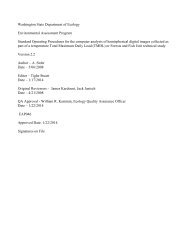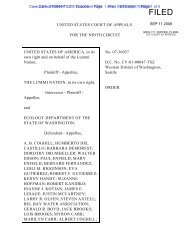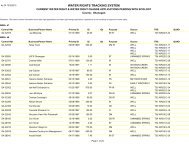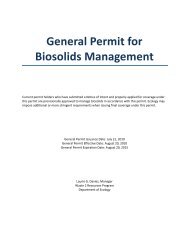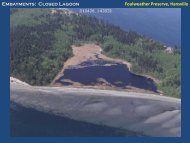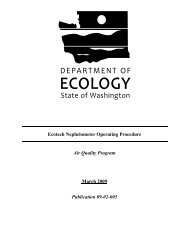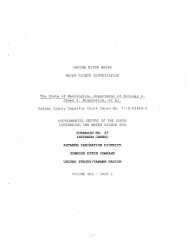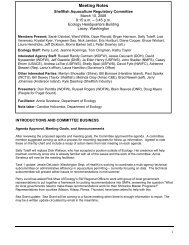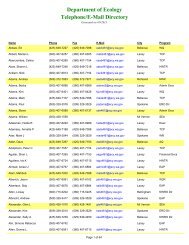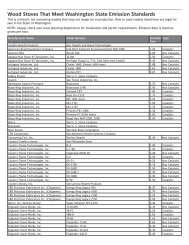WRIA 62 WMP 032305 - Washington State Department of Ecology
WRIA 62 WMP 032305 - Washington State Department of Ecology
WRIA 62 WMP 032305 - Washington State Department of Ecology
You also want an ePaper? Increase the reach of your titles
YUMPU automatically turns print PDFs into web optimized ePapers that Google loves.
March, 2005 -85- 023-1289-003.3040<br />
<strong>WRIA</strong> <strong>62</strong> <strong>WMP</strong> <strong>032305</strong><br />
• Agency commitment;<br />
• Expanded networking; and,<br />
• Building trust in relationships.<br />
8. Improve public involvement through:<br />
• Increasing dialogue among groups working on different issues;<br />
• Increasing public awareness <strong>of</strong> water quality threats and basin history; and,<br />
• Communicating benefits.<br />
5.1.9 Transboundary Gas Group<br />
The Transboundary Gas Group (TGG) is a voluntary coalition <strong>of</strong> agencies, tribes and industry from<br />
Canada and the US that formed in 1998 to address system-wide dissolved gas concentrations<br />
throughout the Columbia River basin. The TGG was formed to help coordinate dissolved gas<br />
planning activities between Canada, the United <strong>State</strong>s, tribes, first nations, and other organizations.<br />
The group’s goal is, "to reduce dissolved gas, on a system-wide basis, in the most cost-effective<br />
manner possible, for all aquatic life."<br />
The Transboundary Gas Group meets twice each year. The latest developments in dissolved gas<br />
monitoring, abatement methods, modeling, and biological effects are discussed at the meetings. The<br />
group has also <strong>of</strong>fered opinions and guidance regarding dissolved gas questions that have arisen in the<br />
Pacific Northwest. Further information about the group can be found at:<br />
www.nwr.noaa.gov/1hydrop/hydroweb/tgg .html.<br />
5.1.10 Columbia River Treaty<br />
The Columbia River Treaty was signed between Canada and the United <strong>State</strong>s on January 17, 1961.<br />
The Treaty relates to the management and use <strong>of</strong> the Columbia River for hydroelectric power<br />
generation, flood control, storage, and diversion. The treaty directed Canada to construct three dams<br />
within Canada (Mica, Keeleyside and Duncan Dams) in order to provide for over 15 million acre feet<br />
<strong>of</strong> storage. The treaty also directed the construction <strong>of</strong> Libby Dam in the United <strong>State</strong>s, whose<br />
reservoir extends into Canada. The construction <strong>of</strong> these storage dams increased flood protection and<br />
provided additional storage and power generation capacity. In return for providing storage on the<br />
Columbia River, the United <strong>State</strong>s agreed to provide Canada with hydroelectric power generated on<br />
the River (or payment for that power), as well as payment for the flood control benefits provided by<br />
the Canadian dams.<br />
5.1.11 VARQ<br />
Variable Discharge, or “VARQ” is the name given to the Army Corps <strong>of</strong> Engineers alternative flood<br />
control operation plan being used at the Hungry Horse reservoir in the Pend Oreille Clark Fork<br />
Drainage. VARQ was designed in response to a National Marine Fisheries Service and US Fish and<br />
Wildlife Service Biological Opinion for the Federal Columbia River Power System. VARQ helps<br />
assure refill <strong>of</strong> the reservoir, and thus helps with flow augmentation for sturgeon, bull trout, salmon<br />
and steelhead stocks listed as threatened or endangered. In addition, VARQ moves some flood



